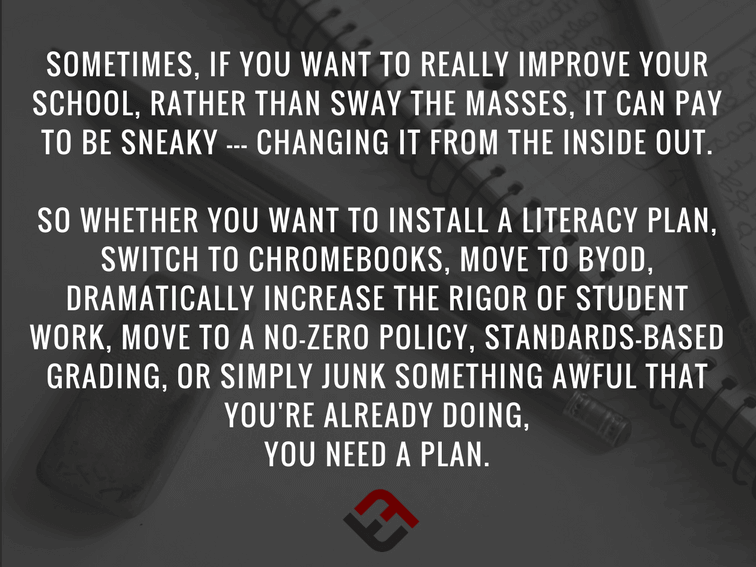
A List Of Sneaky But Effective Simple School Improvement Strategies
by Terry Heick
Education reform is tricky.
For one, so many teachers are wary of change. Not improvement, mind you, but change for the sake of change–shifting from one program or “research-based strategy” to another, endlessly. Year after year.
So many trends in learning are simply repackaged approaches teachers have seen before, and even when that trend is indeed something different, it’s really not.
Everything old is new again.
And even when it is indeed something markedly different, “new stuff” in the past has yielded very little movement of the proverbial needle, so we hesitate. Teacher “buy-in” is hard to come by, and for good reason. Credibility matters.
Complicating the matter is increased pressure for compliance in many districts, with documents, walk-throughs, “non-negotiables,” and comprehensive policies policing it all. Never mind that “same pageness” is challenging across 5 or more content areas and multiple grade levels and dozens of committees, departments, CSIP, CDIPS, and so on.

8 Strategies To Improve Your School Without Anyone Noticing
1. Start small
The idea you’ve been eyeing on project-based learning with + coding and maker learning with every Friday across all English-Language Arts classrooms 9-12 makes sense on paper, but take a second and think. Start first with your classroom, or yours and one more. Work together with a friend, find out what works, focus on the students, iron out the bugs–and do so quietly.
Don’t tweet about your success, or run your mouth about it all at staff meeting. For now, just do it.
See also What Is Genius Hour?
2. Forget about policies
There may be a time when the change needs to become a matter of ‘policy,’ but there are few ways to more quickly ruin a good idea than to make it a ‘policy.’ Forget about making it a matter of legal documents, and just worry about making it work.
3. Know who to avoid
If you know your resident cantankerous curmudgeon who wouldn’t like a winning lottery ticket, much less you and your dag-bern ideas to let kids play with cell phones in class, stay off their lawn. Way off.
4. Pick your battles
Sometimes, you may have to discuss the thinking behind the change you’re making. And that discussion might encounter some resistance. Know when to listen and when to talk (and be sure to really listen) and understand the value of timing.
5. Don’t start a clique
Don’t be that group of teachers that whispers in staff meetings, offers fake smiles in the hallways, and eats lunch together in the same room every day with the door closed. You know who you are. Once people start tying new thinking to individuals and cliques, it’s hopeless.
6. Honor divergent thinking
Disagreement is okay. Use seemingly opposing ideas to better understand the change, how it’s perceived, and what others might ‘need’ to make the change widely successful. If everyone agrees, they’re either lying, or don’t care enough to make it work.
7. Start now
Don’t wait for the planets to align. If you want to change something start small, but start now. Greatness (usually) comes from iteration, not inspiration. Take the rapid prototype approach and get something going sooner rather than later.
5. Work to eventually grow your team
If you want to go fast, go alone; if you want to go far, go together. For now, you’re small. Eventually, there will be more of you. Plan for growth.
The Ed Reform Ninja: 8 Sneaky Strategies For Change In Your School
